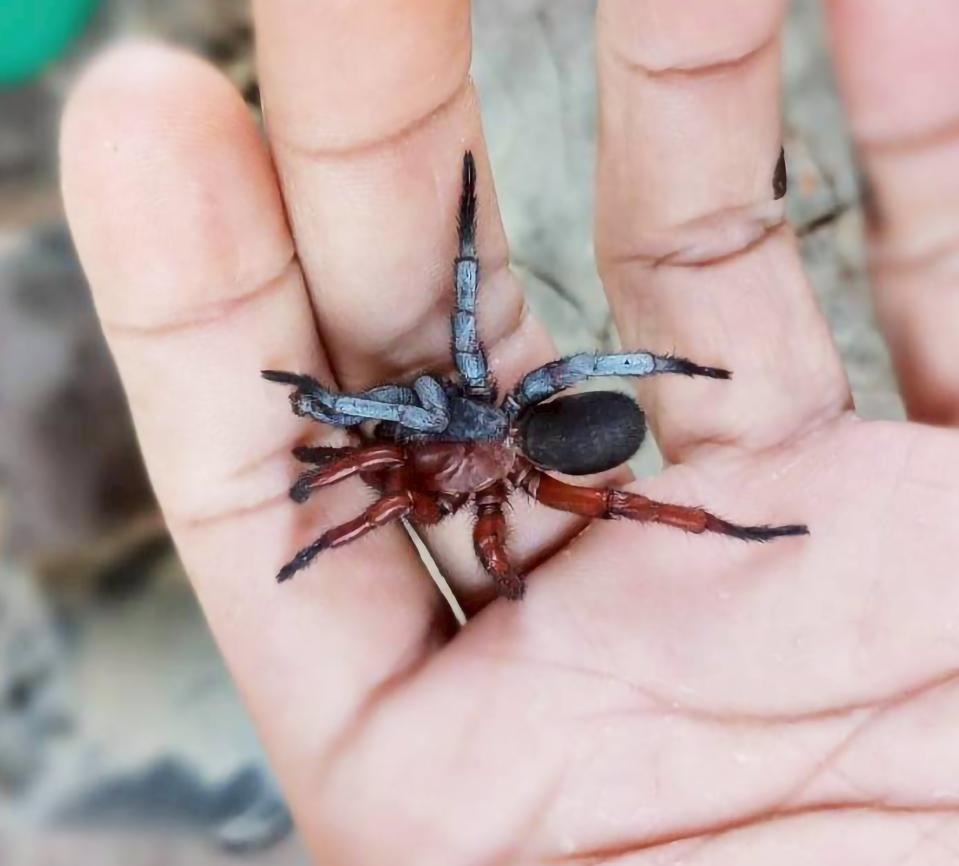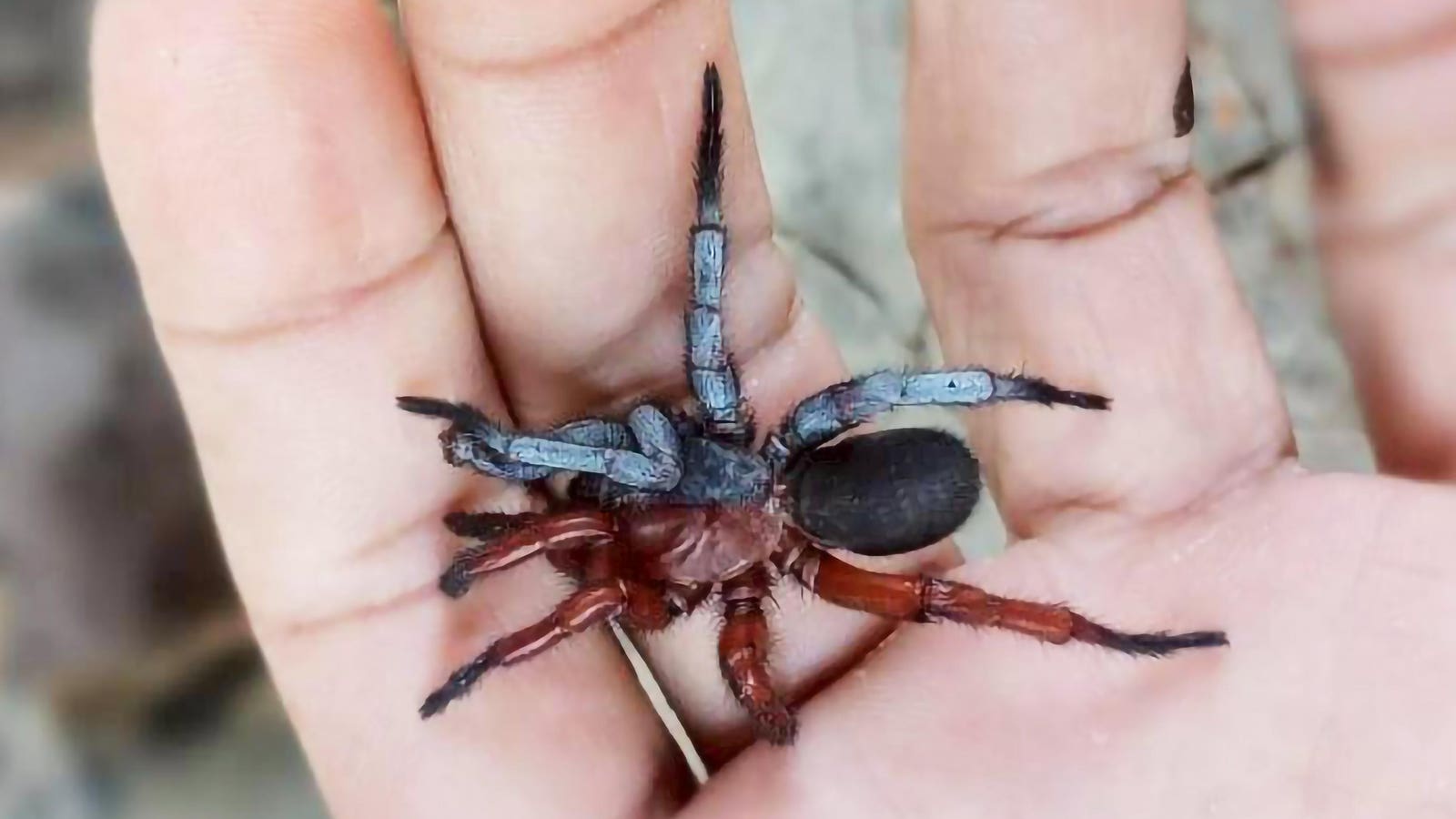Not only is this species new to science, but this remarkable individual is the first record of a rare biological phenomenon (bilateral gynandromorphism) in this previously unknown species.

One of the newly discovered spider was female (orange) on the left side and male (blue-grey) on the right side, a rare condition known as bilateral gynandromorphism. (Credit: Surin Limrudee, via Natapot Warrit.)
Surin Limrudee
A team of scientists recently announced that they have identified a new species of spider that had been discovered near a roadway in a forest in Kanchanaburi (Figure 1). This is a region in western Thailand, along the border with Myanmar. The spiders were unearthed by a trio of men that had been searching the ground for holes, which they then excavated by hand before extracting the spiders from their burrows.
FIGURE 1. Location of the type locality for this study: Nong Rong, Phanom Thuan, Kanchanaburi, in western Thailand (14°09’28.9″N; 99°34’11.6″E, elevation 67 m). A general habitat. (Credit: Patiphan Chamnanpa.)
Patiphan Chamnanpa, doi:10.11646/zootaxa.5696.3.6
When it was realized that these spiders did not resemble anything currently known to science, they were given to researchers at Chulalongkorn University Museum of Natural History for a closer look.
“I am indebted to numerous individuals for this discovery, particularly Mr. Surin Limrudee,” said the study’s lead author, entomologist Chawakorn Kunsete, who is a doctoral student of biology at Chulalongkorn University. Mr Kunsete is working under the mentorship of the study’s senior author, entomologist Natapot Warrit, an assistant professor at Chulalongkorn University. Natapot, who absolutely insisted in email that I address him by his first name rather than as Dr Warrit or as Professor Warrit in this piece, graciously translated all email conversations quoted in this piece, for which I am most grateful.
“His Facebook post featuring a photograph of a gynandromorph spider immediately captured my interest,” Mr Kunsete continued in email. “Upon contacting him, I discerned that the specimen was not only a gynandromorph but also morphologically distinct from any previously described species. This prompted me to seek collaboration with Mr. Limrudee and other colleagues. Through the collection and analysis of additional specimens, we were able to confirm that the specimen indeed represents a new species.”
The discoverers, Mr. Limrudee and colleagues, unearthed and collected both male and female specimens, which have radically different appearances and colorations.
Mr Kunsete, Natapot and collaborators identified the spiders as belonging to the genus Damarchus, a group of burrowing spiders commonly known as “wishbone spiders” or as “mygalomorphs,” which are spiders that build wishbone shaped silk-lined burrows into the ground from where they ambush passing prey.
A male of the new species. (Credit: Surin Limrudee, via Natapot Warrit.)
Surin Limrudee
This spider looks poisonous. Is it?
“There are no formal studies concerning the venom of this species, nor are there documented bite records,” Mr Kunsete replied in email. “However, related families, such as Theraphosidae and Barychelidae, are known to possess venom glands. Moreover, during fieldwork, we frequently observed this spider exhibiting aggressive displays, including the baring of fangs and occasionally the production of droplets at the fang tips. Based on these observations, I infer that the species is probably venomous (to small insects?).”
According to the study, males of the newly reported species had a body length of about 0.6 inches, with eight long legs extending from its body. The entire body of the spider is “covered with (a) white layer (unknown material)” whilst the abdomen underneath is “dark grey” with “pale white spots,” as Mr Kunsete, Natapot and collaborators wrote in their formal species description (ref).
The females of the new species were larger in size than the males and had a different color. Their body length reached up to about an inch, with a dark charcoal grey abdomen and an orange body and legs, according to the formal description. This color combination, along with the overall large size and scary appearance, makes this spider sound like a creature specially designed for Halloween.
A female of the new species. (Credit: Surin Limrudee, via Natapot Warrit.)
Surin Limrudee
The new species was given the name Damarchus inazuma, in recognition of the rare gynandromorph.
“The species is named after Inazuma, a character from the Japanese manga ‘One Piece,’ known for the ability to change sex between male and female. The Inazuma style is characterized by bilateral asymmetry, presenting distinct coloration with orange on the left side and white on the right side,” Mr Kunsete, Natapot and collaborators wrote in their study. “This color arrangement closely mirrors the sexual dimorphism observed in this species, with males exhibiting white coloration and females displaying orange.”
Bilateral gynandromorphism is a rare biological phenomenon characterized by the presence of both male and female traits distinctly manifested on opposite sides of an organism’s body. The causes of bilateral gynandromorphism are still the focus of scientific debate.
“Several hypotheses have been proposed regarding this phenomenon in many arachnids,” Mr Kunsete told me in email. “We hypothesize that it may result from disruptions of the sex chromosome during early developmental stages, specifically at the zygote stage, potentially influenced by factors such as parasites, viruses, or other environmental or biological agents.”
In your study, you mention both hermaphrodites and gynandromorphs: what is the difference?
“Hermaphrodites are organisms that naturally possess both male and female reproductive organs with bilateral symmetry, such as earthworms or certain plants like roses,” Mr Kunsete explained in email. “Gynandromorphs, in contrast, occur in species where individuals are normally one sex only; a single organism shows both male and female characteristics, often split asymmetrically across the body.”
Although it’s possible, it’s unlikely, that a gynandromorph spider of this species can reproduce in the wild.
“Our examination revealed that the specimen possessed spermathecae, the female reproductive organs, indicating the potential for reproductive capability with a male,” Mr Kunsete explained in email. “However, the male reproductive organ (palpal organ) was absent at the time of collection, precluding definitive determination of its ability to mate. In its current state, this specimen would be unable to reproduce autonomously in a natural setting, as the length of the palpal organ is insufficient to reach the female genitalia and transfer sperm for fertilization. Nonetheless, artificial insemination could present a potential means of achieving reproduction in this case.”
This is such a strange creature; what surprised you most about it?
“What surprised me most was that this was not only the first record of a gynandromorph in the Bemmeridae family, but also a new species from Thailand,” Mr Kunsete replied in email. “I feel truly grateful and fulfilled, especially because this discovery was only possible thanks to the support and collaboration of many people.”
Furthermore, the discovery of a gynandromorph in any burrowing spider species is extremely rare.
“[O]ccurrences of gynandromorphism in mygalomorphs (burrowing spiders) are exceedingly rare, with only two formal reports identified exclusively within the Theraphosidae family.”
Source:
Chawakorn Kunsete, Chawatat Thanoosing, Varat Sivayyapram, Prapun Traiyasut & Natapot Warrit (2025). New insights into Damarchus: a new species and gynandromorph description from Thailand (Araneae: Bemmeridae), Zootaxa 5696 (3): 409–424 | doi:10.11646/zootaxa.5696.3.6
© Copyright by GrrlScientist | hosted by Forbes | LinkTr.ee
Socials: Bluesky | CounterSocial | LinkedIn | Mastodon Science | Spoutible | SubStack | Threads | Twitter
